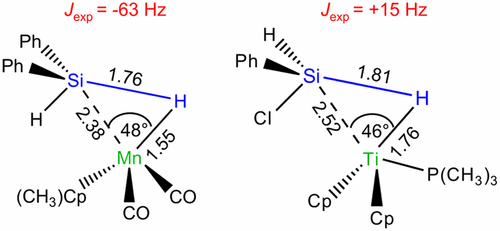当前位置:
X-MOL 学术
›
J. Phys. Chem. A
›
论文详情
Our official English website, www.x-mol.net, welcomes your
feedback! (Note: you will need to create a separate account there.)
J(Si,H) Coupling Constants of Activated Si–H Bonds
The Journal of Physical Chemistry A ( IF 2.7 ) Pub Date : 2017-09-18 00:00:00 , DOI: 10.1021/acs.jpca.7b05830 Petra Meixner 1 , Kilian Batke 1 , Andreas Fischer 1 , Dominik Schmitz 1 , Georg Eickerling 1 , Marcel Kalter 1 , Klaus Ruhland 1 , Klaus Eichele 2 , José E. Barquera-Lozada 3 , Nicola P. M. Casati 4 , Fabio Montisci 5 , Piero Macchi 5 , Wolfgang Scherer 1
The Journal of Physical Chemistry A ( IF 2.7 ) Pub Date : 2017-09-18 00:00:00 , DOI: 10.1021/acs.jpca.7b05830 Petra Meixner 1 , Kilian Batke 1 , Andreas Fischer 1 , Dominik Schmitz 1 , Georg Eickerling 1 , Marcel Kalter 1 , Klaus Ruhland 1 , Klaus Eichele 2 , José E. Barquera-Lozada 3 , Nicola P. M. Casati 4 , Fabio Montisci 5 , Piero Macchi 5 , Wolfgang Scherer 1
Affiliation

|
We outline in this combined experimental and theoretical NMR study that sign and magnitude of J(Si,H) coupling constants provide reliable indicators to evaluate the extent of the oxidative addition of Si–H bonds in hydrosilane complexes. In combination with experimental electron density studies and MO analyses a simple structure–property relationship emerges: positive J(Si,H) coupling constants are observed in cases where M → L π-back-donation (M = transition metal; L = hydrosilane ligand) dominates. The corresponding complexes are located close to the terminus of the respective oxidative addition trajectory. In contrast negative J(Si,H) values signal the predominance of significant covalent Si–H interactions and the according complexes reside at an earlier stage of the oxidative addition reaction pathway. Hence, in nonclassical hydrosilane complexes such as Cp2Ti(PMe3)(HSiMe3-nCln) (with n = 1–3) the sign of J(Si,H) changes from minus to plus with increasing number of chloro substituents n and maps the rising degree of oxidative addition. Accordingly, the sign and magnitude of J(Si,H) coupling constants can be employed to identify and characterize nonclassical hydrosilane species also in solution. These NMR studies might therefore help to reveal the salient control parameters of the Si–H bond activation process in transition-metal hydrosilane complexes which represent key intermediates for numerous metal-catalyzed Si–H bond activation processes. Furthermore, experimental high-resolution and high-pressure X-ray diffraction studies were undertaken to explore the close relationship between the topology of the electron density displayed by the η2(Si–H)M units and their respective J(Si,H) couplings.
中文翻译:

活化的Si-H键的J(Si,H)耦合常数
我们在这项结合实验和理论NMR的研究中概述了J(Si,H)耦合常数的符号和大小为评估氢硅烷络合物中Si–H键的氧化加成程度提供了可靠的指标。结合实验电子密度研究和MO分析,出现了一种简单的结构与性质的关系:在M→Lπ返配(M =过渡金属; L =氢硅烷配体)的情况下,观察到正的J(Si,H)耦合常数。 )占主导地位。相应的配合物位于相应的氧化加成轨迹的末端附近。相反,负J(Si,H)值表明存在显着的共价Si-H相互作用,并且相应的络合物位于氧化加成反应路径的早期。因此,在非经典氢硅烷配合物中,例如Cp 2 Ti(PMe 3)(HSiMe 3- n Cl n)(n = 1-3)中,J(Si,H)的符号随着氯数量的增加而从负变为正。取代基n和b映射了氧化加成的上升程度。因此,J的符号和大小(Si,H)偶合常数也可用于鉴定和表征溶液中的非经典氢硅烷物质。因此,这些NMR研究可能有助于揭示过渡金属氢硅烷络合物中Si-H键活化过程的显着控制参数,这些代表了许多金属催化的Si-H键活化过程的关键中间体。此外,实验高分辨率和高压X射线衍射研究,进行探讨的电子密度的拓扑结构之间的密切关系由η显示2(SI-H)M单元和它们各自的Ĵ(SI,H)联轴器。
更新日期:2017-09-18
中文翻译:

活化的Si-H键的J(Si,H)耦合常数
我们在这项结合实验和理论NMR的研究中概述了J(Si,H)耦合常数的符号和大小为评估氢硅烷络合物中Si–H键的氧化加成程度提供了可靠的指标。结合实验电子密度研究和MO分析,出现了一种简单的结构与性质的关系:在M→Lπ返配(M =过渡金属; L =氢硅烷配体)的情况下,观察到正的J(Si,H)耦合常数。 )占主导地位。相应的配合物位于相应的氧化加成轨迹的末端附近。相反,负J(Si,H)值表明存在显着的共价Si-H相互作用,并且相应的络合物位于氧化加成反应路径的早期。因此,在非经典氢硅烷配合物中,例如Cp 2 Ti(PMe 3)(HSiMe 3- n Cl n)(n = 1-3)中,J(Si,H)的符号随着氯数量的增加而从负变为正。取代基n和b映射了氧化加成的上升程度。因此,J的符号和大小(Si,H)偶合常数也可用于鉴定和表征溶液中的非经典氢硅烷物质。因此,这些NMR研究可能有助于揭示过渡金属氢硅烷络合物中Si-H键活化过程的显着控制参数,这些代表了许多金属催化的Si-H键活化过程的关键中间体。此外,实验高分辨率和高压X射线衍射研究,进行探讨的电子密度的拓扑结构之间的密切关系由η显示2(SI-H)M单元和它们各自的Ĵ(SI,H)联轴器。











































 京公网安备 11010802027423号
京公网安备 11010802027423号